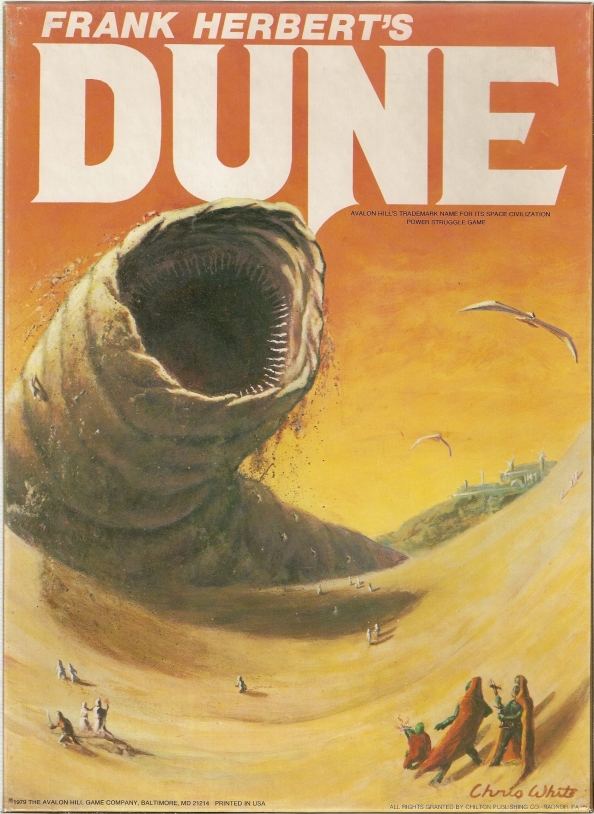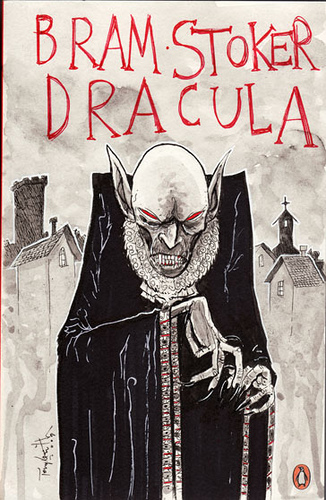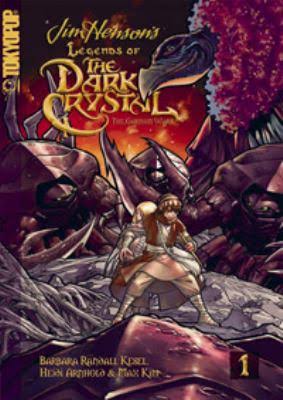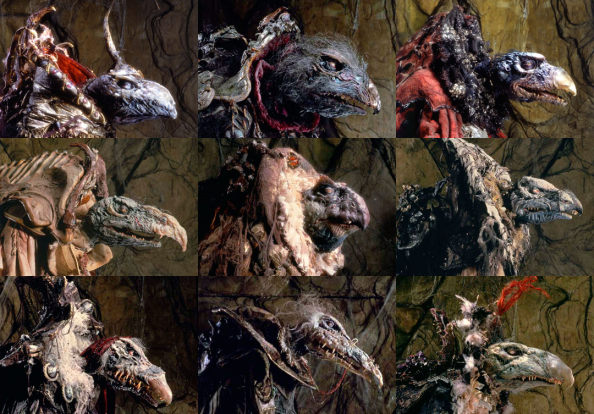 Way back in 11th grade, my friends and I watched in jaded horror as our English teacher posted the famous College Reading List, the one thing in existence that condemns more people’s culture and interests than Fox News, police who pull over black men, and your grandfather at Thanksgiving dinner combined. This was the list of the ONLY BOOKS WORTH READING if you didn’t want to wind up trading your sperm for heroine so you didn’t die of withdrawal in a federal prison cell some day. While I was fuming over the fact that the Sword of Shannara made it on the list due to an unused historical footnote about nuclear annihilation, which apparently gave the book a message and therefore far more value than the story it plagiarized, my friend Al noted another curiosity. “Dune?” he said. “Usually people just go watch the movie, but why don’t you just go play the video game?” I’ve decided to take Thanksgiving off, but to spice up your holiday, I thought I’d do a special double entry on Frank Herbert’s Dune and its Sega CD adaptation.
Way back in 11th grade, my friends and I watched in jaded horror as our English teacher posted the famous College Reading List, the one thing in existence that condemns more people’s culture and interests than Fox News, police who pull over black men, and your grandfather at Thanksgiving dinner combined. This was the list of the ONLY BOOKS WORTH READING if you didn’t want to wind up trading your sperm for heroine so you didn’t die of withdrawal in a federal prison cell some day. While I was fuming over the fact that the Sword of Shannara made it on the list due to an unused historical footnote about nuclear annihilation, which apparently gave the book a message and therefore far more value than the story it plagiarized, my friend Al noted another curiosity. “Dune?” he said. “Usually people just go watch the movie, but why don’t you just go play the video game?” I’ve decided to take Thanksgiving off, but to spice up your holiday, I thought I’d do a special double entry on Frank Herbert’s Dune and its Sega CD adaptation.

Starring Kim Jung-un as Duncan Idaho, the legendary Scottish Highland potato farmer.
The novel tells a story of a spice mined on the desert planet, Arrakis. The Spice increases life span, expands consciousness, lets you fold time and space, and basically does every profound thing people tell you weed does before you smoke your first joint and spend two hours giggling over how profoundly funny it is to say the word “crayons” backwards. The folding-time-and-space qualities, though, being rather helpful for space travel, makes the spice rather important for imperial expansion, so Dune opens on a setting of space-colonialism, exploitation of resources, and cultural appropriation that I guess we’re all just supposed to be okay with. Paul Atreides, a fifteen-year-old nobleman (who Herbert keeps describing as though he were ten), comes to the planet with his father, the duke, to oversee the mining operations for the emperor, and as long as they’re there, to provide a white-skinned overlord for the Fremen, the vaguely Arabic natives of the planet. But, hey, it’s not racist because the old nobleman, Baron Harkonnen was downright genocidal, so in a way, the Atreides are doing them a favor, right? Plus, setting up Paul as the Fremen messiah saves them the trouble of whitewashing him like we did to Jesus.

I’m dead sexy!
But whatever. Harkonnen is fat and ugly while Paul is young and beautiful, and as several of my ex girlfriends will tell you, anything that a pretty person does is morally pure just on virtue of being attractive and popular. But Paul, being a good sport, goes into hiding with the Fremen after Harkonnen goes all teen-slasher-flick on his family. There he must learn their ways and become accepted among them, like Jane Goodall among the apes. Through displays of hand-to-hand combat, he wins the Fremen’s respect (not to mention the wife of the man he kills and an adoring young fangirl), learns how to wrangle the vicious predatory sandworms, expands his mind through the casual use of drugs, and just happens to discover the secret connection between the worms and the spice (hint: I’m pretty sure it’s the active ingredient in Slurm).

Melange…it’s highly addictive!

Yeah, I fell asleep and my two-year-old found the hair clippers.
The book does have a definite 18th-century white supremacy vibe to it, just shy of packing the Fremen onto spaceships and sending them to Tatooine to work on Jabba’s moisture plantations, but beyond that it tells a pretty compelling story of Paul’s mythological transformation into messiah, along with a political savvy the likes of which the U.S. hasn’t seen since…uh…well, for lack of a better example, let’s say the last season of Game of Thrones. Such a complex, masterful tale is definitely worth the read. So what about the game? Can I save myself the time and effort and get the same effect out of a Sega CD?

Such wonderful graphics! Do you know what we need in this game? Hours more of this image right here.
Let me put it this way: I’ve seen better adaptations from eighty-year-old men in computer labs. I’ve seen tumors with more respect for their source material. You’d find more literary value by reading a shredded condom wrapper on the floor of a public restroom. The Sega CD Dune adaptation is a fairly straightforward point-and-click adventure, likely coming to us by way of the 1984 movie, which I confess I have never seen. Frank Herbert gave us a philosophical examination of the role of religion and politics in the course of human history, and Cryo Interactive distilled the essence of the story down to long ornithopter rides through desert wasteland. And when I say long, I mean I’d set the game to fly to a new location, then go off to use the bathroom, have a conversation with Anne, pick up the dry cleaning, or partake in a vision quest deep in the woods for a week or two before coming back to check on the progress. I guess it’s sort of neat how they sync the video with the map, where dark spots on the map correspond to rocky sections of the desert, but I’d have to be dropping some hardcore spice before my brain wants to sit and watch that for ten minutes at a time.

Paul Atreides, meet Paul Rubens
Dune works as a book because everyone can relate to a coming-of-age story, and when your other coming-of-age stories suggest that you might discover freedom among the antebellum American South, or that your papa will marry you off to a well-bred Victorian gentleman, Frank Herbert strokes our egos by suggesting the final step in growing up is apotheosis, that the truly special among us will become messiahs (which might be easier to swallow for those of you who don’t struggle just to get a handful of people to follow your blog). Cryo Interactive, however, dumped any insightful bildungsroman in order to double down on the white man’s burden, dropping it solidly in Paul’s lap. As Paul, you fly your giant metal mosquito to each of the Fremen settlements in order to command them to, “Work for me.” And, of course, the Fremen are more than happy to oblige, being underdeveloped minorities who will forever live as uncivilized barbarians lest they have some white boy Bon Jovi groupie show up to give them directions.

…please don’t.
As I mentioned, the game is likely based on the 1984 movie, however its obvious from the inconsistent art style that not everyone signed off on their likeness rights. Jessica and Princess Irulean quite clearly were converted directly from the film, with Irulean’s opening narration still intact. Paul still looks photorealistic, but somewhere in development they decided to give Kyle MacLachlan hair like a Soul Glo model. Duke Leto Atreides is just someone’s drawing of a Star Wars villain, and someone in the art department is clearly pranking Patrick Stewart, making his character look like the hell spawn of Buffalo Bill and Pennywise the clown on his way to audition for the role of Dr. Frank N. Furter.

Dad…why did you wink at me when you said that?
Theoretically, the game eventually shifts focus away from being a point-and-click mining management simulator, and you can begin to raise and equip troops to fight the Harkonnens, so I gather it turns into something like Age of Empires meets Microsoft flight simulator, minus all the fun parts of each. But let’s get right down to it…forget the politics, forget the character development, forget the mythology, even…the reason you play a Dune game is because of sand worms. And if I have to fly around the same boring desert landscape for fifteen hours before I even catch a glimpse of one, I’m going to go watch Beetlejuice instead.
 Well this is quickly becoming the year of the vampire. Having torn through a streak of Castlevania games like a box of Oreos the day after abandoning a diet, I thought it best to remind myself that actual horror aims to be frightening. Since fear necessarily requires some degree of permanency in death, anything truly horrifying about these games tends to be mitigated by chronic resurrection and the power to murder hoards of tiny monsters to do a few extra points of damage against Dracula. Other than possibly explaining Renfield’s behavior, these video game conventions don’t so much hit the spirit of vampire horror as they do an episode of American Ninja Warriors where all the competitors are professional dominatrixes. So since October somehow became my month to call up all things Halloweenish, I thought I’d go back and read the original Dracula, by Bram Stoker.
Well this is quickly becoming the year of the vampire. Having torn through a streak of Castlevania games like a box of Oreos the day after abandoning a diet, I thought it best to remind myself that actual horror aims to be frightening. Since fear necessarily requires some degree of permanency in death, anything truly horrifying about these games tends to be mitigated by chronic resurrection and the power to murder hoards of tiny monsters to do a few extra points of damage against Dracula. Other than possibly explaining Renfield’s behavior, these video game conventions don’t so much hit the spirit of vampire horror as they do an episode of American Ninja Warriors where all the competitors are professional dominatrixes. So since October somehow became my month to call up all things Halloweenish, I thought I’d go back and read the original Dracula, by Bram Stoker. Greetings, O my brothers! My appypolly loggy for this. I don’t mean to gavoreet about every book read, but this one is real horrorshow for the sarky, so I couldn’t resist the urge. Most of you likely slooshied about Clockwork Orange through the sinny, but it turns out it was a horrorshow book long before that Kubrik veck got his rookers on it. Problem is, as you might viddy by now, is that chelloveck, Anthony Burgess, used some bezoomny slovos, so that one viddy at the page and you feel like you’ve been tolchocked hard in the gulliver.
Greetings, O my brothers! My appypolly loggy for this. I don’t mean to gavoreet about every book read, but this one is real horrorshow for the sarky, so I couldn’t resist the urge. Most of you likely slooshied about Clockwork Orange through the sinny, but it turns out it was a horrorshow book long before that Kubrik veck got his rookers on it. Problem is, as you might viddy by now, is that chelloveck, Anthony Burgess, used some bezoomny slovos, so that one viddy at the page and you feel like you’ve been tolchocked hard in the gulliver. Having read one of the most amazing novels of my life, I naturally couldn’t wait to jump on to write about it and spread the glory of Ernest Cline’s paean to 1980s pop culture, Ready Player One. However, over the past two weeks of delays and distractions, I’ve come to the realization that God is most likely a triumvirate of Vlad the Impaler, H.H. Holmes, and the Mark Hamil Joker, because there’s no other way I can explain the series of sadistic practical jokes that the universe seems to take such joy in throwing at my daily goals and aspirations. To be specific, I’d like to tell you about a fascinating future where people escape from a socio-political dystopia by burying themselves in the most awesome virtual reality world anyone could possibly dream up, but I couldn’t because the SD card I use as a portable hard drive somehow was switched to read-only, and although there are plenty of commands in place for changing drive permissions, I can’t use any of them because the disk is read-only. Honestly, I consider myself a pacifist, but whoever set up read-write permissions this way is really making a good argument in favor of burning people at the stake.
Having read one of the most amazing novels of my life, I naturally couldn’t wait to jump on to write about it and spread the glory of Ernest Cline’s paean to 1980s pop culture, Ready Player One. However, over the past two weeks of delays and distractions, I’ve come to the realization that God is most likely a triumvirate of Vlad the Impaler, H.H. Holmes, and the Mark Hamil Joker, because there’s no other way I can explain the series of sadistic practical jokes that the universe seems to take such joy in throwing at my daily goals and aspirations. To be specific, I’d like to tell you about a fascinating future where people escape from a socio-political dystopia by burying themselves in the most awesome virtual reality world anyone could possibly dream up, but I couldn’t because the SD card I use as a portable hard drive somehow was switched to read-only, and although there are plenty of commands in place for changing drive permissions, I can’t use any of them because the disk is read-only. Honestly, I consider myself a pacifist, but whoever set up read-write permissions this way is really making a good argument in favor of burning people at the stake. Utah. America’s El Dorado. Not, of course, in the sense that there’s anything valuable there. It’s more of a matter of no one really knows if it exists or not, and no one ever goes there. Tis a barren, inhospitable landscape with few resources save for dirt, salt, wives, fake moon landing studios, and jokes about Utah. Oh, and Brandon Sanderson novels. For those of you unfamiliar with the name, Sanderson made his fame by taking over the Wheel of Time series after Robert Jordan made everyone worry about George R.R. Martin’s health. Since then, his name has appeared on top-100 fantasy lists with such a high frequency that he violates FCC regulations. So I thought I’d read Mistborn: The Final Empire to see what all the fuss is about. In short, the book was good enough that I had to resort to jokes about Utah to fill out this review.
Utah. America’s El Dorado. Not, of course, in the sense that there’s anything valuable there. It’s more of a matter of no one really knows if it exists or not, and no one ever goes there. Tis a barren, inhospitable landscape with few resources save for dirt, salt, wives, fake moon landing studios, and jokes about Utah. Oh, and Brandon Sanderson novels. For those of you unfamiliar with the name, Sanderson made his fame by taking over the Wheel of Time series after Robert Jordan made everyone worry about George R.R. Martin’s health. Since then, his name has appeared on top-100 fantasy lists with such a high frequency that he violates FCC regulations. So I thought I’d read Mistborn: The Final Empire to see what all the fuss is about. In short, the book was good enough that I had to resort to jokes about Utah to fill out this review. Between my recent attempt to finish FFXII fast enough to merit a felony-level speeding ticket and late night news coverage and my exploits as a CPR instructor, breathing into plastic dummies and explaining to people that, “No, these people won’t have the decency to crawl up on a table before the pass out just to accommodate the fact that you weigh six hundred pounds and your knees hurt on the ground,” I’ve gotten a bit behind on my entries. To add to that, living in 1938 Nazi Germany with a leader who is constantly both on the brink of war and looking at his own people like he’s trying to decide how much zyklon b he’ll need to get has somewhat dulled my capacity for humor. So I might as well try to distract myself from the next
Between my recent attempt to finish FFXII fast enough to merit a felony-level speeding ticket and late night news coverage and my exploits as a CPR instructor, breathing into plastic dummies and explaining to people that, “No, these people won’t have the decency to crawl up on a table before the pass out just to accommodate the fact that you weigh six hundred pounds and your knees hurt on the ground,” I’ve gotten a bit behind on my entries. To add to that, living in 1938 Nazi Germany with a leader who is constantly both on the brink of war and looking at his own people like he’s trying to decide how much zyklon b he’ll need to get has somewhat dulled my capacity for humor. So I might as well try to distract myself from the next 
 Now that our president has the motivations of a Bond villain and the brain of a kumquat, I think there’s one question on all of our minds: What post-nuclear-apocalyptic world would I most like to live in? McCarthy’s The Road? Bethesda’s Fallout? While selecting your favorite hypothetical misery, let’s not forget that science fiction doesn’t have the monopoly on the nuclear apocalypse (at least not under American business practices, where at least a half dozen corporations are vying for that monopoly themselves), and that there’s one apocalyptic landscape that actually doesn’t sound too damn bad: Shannara.
Now that our president has the motivations of a Bond villain and the brain of a kumquat, I think there’s one question on all of our minds: What post-nuclear-apocalyptic world would I most like to live in? McCarthy’s The Road? Bethesda’s Fallout? While selecting your favorite hypothetical misery, let’s not forget that science fiction doesn’t have the monopoly on the nuclear apocalypse (at least not under American business practices, where at least a half dozen corporations are vying for that monopoly themselves), and that there’s one apocalyptic landscape that actually doesn’t sound too damn bad: Shannara. January 25th, 2017
January 25th, 2017 If books were children, the treatment I’ve given them lately may not land me in jail, but I might get a stern talking-to by Social Services. Oh, the ironies of teaching literature, spending all day long with books and coming home without enough energy to charge a cell phone while it’s still on. If I had book shelves beneath my stairs, I could compare myself to the Dursleys, literally keeping Harry Potter in the pantry all the time. As such, I feel that the last few books I’ve read, I’ve been about as fair and balanced as a rusted-out bathroom scale shoved in a closet in a Fox News studio. Fortunately, I’ve found one I can get through and enjoy without the regret of wasted time and money you get when the high class escort girl you hired isn’t the one from the picture on the website. What’s more, the book stems from the world of the 80-minute Jim Henson production, The Dark Crystal. Managing to make a movie-based book that expands the lore and, what’s more, manages to capture the Jim Henson feel without the muppets, is a task that ranks up there with slaying the Nemean lion, destroying the One Ring, and reading a presidential ballot when you want to vote for the guy who hates words. But somehow, author J.M. Lee managed to bring skeksis back with his book, Shadows of the Dark Crystal.
If books were children, the treatment I’ve given them lately may not land me in jail, but I might get a stern talking-to by Social Services. Oh, the ironies of teaching literature, spending all day long with books and coming home without enough energy to charge a cell phone while it’s still on. If I had book shelves beneath my stairs, I could compare myself to the Dursleys, literally keeping Harry Potter in the pantry all the time. As such, I feel that the last few books I’ve read, I’ve been about as fair and balanced as a rusted-out bathroom scale shoved in a closet in a Fox News studio. Fortunately, I’ve found one I can get through and enjoy without the regret of wasted time and money you get when the high class escort girl you hired isn’t the one from the picture on the website. What’s more, the book stems from the world of the 80-minute Jim Henson production, The Dark Crystal. Managing to make a movie-based book that expands the lore and, what’s more, manages to capture the Jim Henson feel without the muppets, is a task that ranks up there with slaying the Nemean lion, destroying the One Ring, and reading a presidential ballot when you want to vote for the guy who hates words. But somehow, author J.M. Lee managed to bring skeksis back with his book, Shadows of the Dark Crystal. The book serves as a distant prequel to the Dark Crystal film, set way back in a time when gelflings weren’t harder to find than a Mormon strip club. In fact, the skeksis employed them as guards in their palace, and the gelflings served with a sense of pride, patriotism, and Stockholm syndrome that would rival that of even Hispanic and female Trump voters. (Preemptive apology for any political tone in today’s post, but I’m writing less than a week after the election, and we in the U.S. are currently a little worried that our hallowed democracy and electoral college will soon be replaced with
The book serves as a distant prequel to the Dark Crystal film, set way back in a time when gelflings weren’t harder to find than a Mormon strip club. In fact, the skeksis employed them as guards in their palace, and the gelflings served with a sense of pride, patriotism, and Stockholm syndrome that would rival that of even Hispanic and female Trump voters. (Preemptive apology for any political tone in today’s post, but I’m writing less than a week after the election, and we in the U.S. are currently a little worried that our hallowed democracy and electoral college will soon be replaced with 